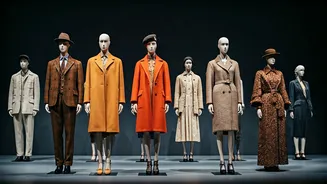Ancient Roots of Style
Fashion's roots trace back to ancient civilizations. Clothing in these eras served essential functions, primarily protection from the elements. Egyptians,
Greeks, and Romans developed their unique approaches to apparel. The Egyptians were known for their linen garments, signifying status through the fabric's quality and embellishments like jewelry and makeup. The Greeks emphasized draped garments, such as the chiton and himation, which allowed for freedom of movement. The Romans built on these principles, incorporating tunics, togas, and elaborate accessories. These early styles set the stage for later fashion trends and showed how clothing became an expression of identity and social standing. The use of natural materials, weaving techniques, and the earliest forms of adornment were significant in this period.
Medieval & Renaissance Trends
The Middle Ages and Renaissance witnessed a surge in fashion diversity. The medieval period saw the emergence of structured garments, with different silhouettes that reflected the societal hierarchy. The wealthy wore luxurious fabrics like silk and velvet, while the working class used simpler materials. The Renaissance sparked a renewed interest in art, culture, and fashion. This era celebrated intricate designs and opulent details. Sumptuous fabrics, elaborate embellishments, and elaborate silhouettes characterized the period. From the flowing gowns of the ladies to the tailored doublets of the gentlemen, the Renaissance showcased fashion's capability for artistic expression and status. Innovations in tailoring and the rise of fashion centers in Italy and France propelled this evolution.
The Rise of Modern Fashion
The Industrial Revolution and its technological advancements revolutionized fashion. Mass production made clothing more accessible and affordable. This marked a turning point, with fashion expanding beyond the elite. The late 19th and early 20th centuries saw the emergence of fashion houses and the influence of iconic designers. Coco Chanel's simple, elegant designs and Christian Dior's New Look were revolutionary. These designers introduced innovative silhouettes and fabrics, which transformed fashion into a global industry. World War I and II influenced fashion, introducing practical and utilitarian styles that reflected the social changes. The rise of ready-to-wear clothing and the growing influence of media propelled the rapid dissemination of styles.
20th-Century Revolutions
The 20th century witnessed significant fashion revolutions. The Art Deco movement brought geometric patterns and bold colors, while the 1960s saw the youth culture influencing fashion. Mini skirts, psychedelic prints, and the emergence of street style defined the decade. Designers like Mary Quant and André Courrèges challenged traditional norms. The 1970s explored a variety of styles, from disco-inspired glamour to punk rock's rebellious aesthetics. The 1980s embraced bold silhouettes and power dressing, with shoulder pads and statement accessories. Fashion was now about personal expression and a reflection of diverse lifestyles. The rise of designer labels and the globalization of fashion further enhanced the industry's reach.
Fashion in the Digital Age
The digital age has brought dramatic changes to the fashion world. E-commerce, social media, and the internet have democratized fashion trends. Fast fashion offers a continuous stream of new styles. Influencers and bloggers shape consumer preferences, and trends are rapidly shared and adapted globally. Sustainability and ethical practices are becoming more significant concerns. Consumers are increasingly demanding environmentally friendly and fair-trade practices. Technology also has a huge role, including the development of innovative fabrics, 3D printing of clothing, and virtual fashion experiences. Fashion is embracing diversity, with a greater emphasis on inclusivity. This era continues to shape how we view, consume, and experience fashion.













